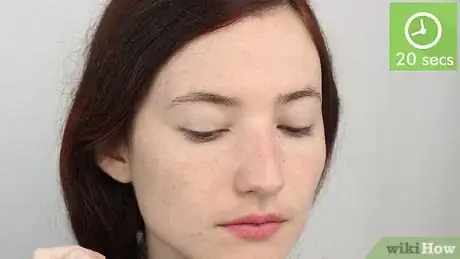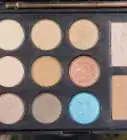This article was co-authored by Devorah Kuperland. Devorah Kuperland is a Makeup Artist and the Founder of Glam By Dev, a New York City-based business specializing in bridal, special events, and editorial campaigns. Devorah has over five years of professional makeup consulting experience and her work has been featured in New York's Bridal Fashion Week.
There are 11 references cited in this article, which can be found at the bottom of the page.
wikiHow marks an article as reader-approved once it receives enough positive feedback. In this case, 90% of readers who voted found the article helpful, earning it our reader-approved status.
This article has been viewed 169,235 times.
There's nothing more frustrating than laboring over your eye makeup in the morning, only to have it fade by lunchtime. What's the point of perfecting your cat eye when it's wiped off or melting down your face by the time you're ready to go out? Luckily, with the super quick, super easy application an eyelid primer, you can rest assured your eye makeup will stay in place all day.
Steps
Applying Eye Primer
-
1Cleanse your face and apply moisturizer. It is essential to always start with a clean face, removing any oil or dirt that may be on your skin. Moisturizer will keep the makeup from drying out your skin. Wait at least 20 seconds after applying moisturizer, or until your skin feels dry and not dewy.[2]
-
2Dab a small amount of primer on the back of your hand. The amount should only be about the size of a grain of rice. While you want the primer to cover your eyelid completely, too much primer can completely backfire. It can cause your makeup to pill, clump, appear chalky, or look shiny. Too little, and your eye makeup won't stay.[3]
- This amount of primer should be enough for both eyes.
- It's always better to start with less product and build layers if you need to instead of starting with too much and trying to wipe it off. Remember: less is more when it comes to primer.
-
3Dab the primer onto your eyelid with your finger or a small brush. You want to gently dab, pat, smooth, and blend (but not rub) the primer into your skin. Use gentle pressure, as your eyelid skin is very thin. You can start near the inner corner of your eye and spread out and up toward the brow bone and outer corner of your lid, or you can start at the center of your lid and blend outwards and upwards.[4]
- A (clean) finger is a perfect tool for applying primer, and most of the time it's all you will need. You can easily control how much product you are applying, and the warmth from your fingertips can help you spread the primer.
- A small makeup brush can really get into the little corners and edges by your tear duct and lash line and usually helps you get an even application.
- Always be gentle and never pull on the skin around your eye, as this can lead to sagging and wrinkles later in life.
- Really work the primer into the creases of your eyelid. The primer's job is to fill the fine lines in your skin so that your makeup doesn't settle into the creases.
- If you are applying makeup to your bottom lid, use a thin brush or your finger to gently dab it along your lower lash line.
-
4Allow the primer to dry before completing your eye makeup. It should take about 20 seconds for the primer to absorb and dry. You can then apply your eye makeup as you normally would. Your eyelid should feel like a flat canvas and your shadow should go on smoothly. If it appears cakey or clumpy, you used too much primer and should use a little less next application.[5]
- Try using the primer on your eyebrows to keep brow powder in place, too.[6]
Choosing a Primer
-
1Choose the right shade of primer. For general, everyday use, you want to look for a primer that matches your complexion or is just a tiny bit lighter. This will look the most natural if you forego eyeshadow and just do a liner and it won't alter the shade of your eyeshadow by adding pigmentation.[7]
- Keep in mind that using a tinted primer can affect the look of your eyeshadow. You'll get the truest color if you stick to a transparent primer or one with very little color.
- If you're doing a smokey eye or a dark eyeshadow, look for a darker primer to add depth to your look. If you are using multiple colors and really want them to pop, try a white primer.
- Consider color correcting primer if you have dark circles or want to brighten your eyes. Primers with a yellow or peach cast will neutralize the purples, browns, and "bruise" shades of under eye circles.
- A primer with a little bit of green can neutralize pink or reddish skin.
-
2Choose the finish of your primer. Matte primers are great for everyday use, because they tend to last longer and give you a more neutral base for your eye makeup. Even if your skin is not oily, eyelids tend to get a little greasy throughout the day, and the matte finish will help absorb the grease and keep your makeup in place.[8]
- Since primer is a base to even out your skin tone, it should really be matte or transparent, rather than shimmery.[9]
- A satin or shimmery finish works when you are wearing no shadow over your primer or plan to use a sparkly eyeshadow. Keep in mind these don't have quite the staying power as a matte primer, and that you shouldn't use a matte eyeshadow over a shimmery primer or it will look off.
- If you have very dry skin, try a gel-based primer or one that illuminates skin.
- Matte primers work with both matte and shimmery eyeshadows--they allow you to add all the shine using the makeup, not the primer.
- Matte primers are especially effective in hot and humid weather, because it will keep the grease and shine under control.
-
3Choose the texture of your eye primer. Primers come in gel, cream, liquid, or stick form. The texture of your primer will influence how it feels on your lids and how long it will last. Gel primers usually last the longest and can be worn with all types of eyeshadow. They're great in hot weather and minimizing creasing.[10]
- Cream primers have a mousse texture and are the easiest to find. They work with most eyeshadows and can feel a little heavier on your lids.
- Liquid primers are very lightweight, but are prone to showing creases if applied too lightly. Make sure you thoroughly blend liquid primers into the creases of your eyelids when applying.
- Stick primers can be applied directly to your eyelid, instead of using your finger or a brush. They are very convenient for this reason, however it can be difficult to gauge how much primer you are applying.[11]
-
4Make your own primer out of aloe vera and glycerin if you run out. Mix together 1 teaspoon (4.9 mL) of white kaolin clay, 1 teaspoon (4.9 mL) of aloe vera gel, and 1 teaspoon (4.9 mL) of vegetable glycerin. Combine your ingredients until they’re smooth, then dab the mixture onto your eyelids with a cotton swab. Try not to get any in your eyes, or it might sting a little.[12]
- Aloe vera and vegetable glycerin both absorb oil, so it makes them perfect for an eyelid primer to absorb shine.
Expert Q&A
Did you know you can get expert answers for this article?
Unlock expert answers by supporting wikiHow
-
QuestionDo you put eye primer on before or after foundation?
 Laura MartinLaura Martin is a Licensed Cosmetologist in Georgia. She has been a hair stylist since 2007 and a cosmetology teacher since 2013.
Laura MartinLaura Martin is a Licensed Cosmetologist in Georgia. She has been a hair stylist since 2007 and a cosmetology teacher since 2013.
Licensed Cosmetologist
-
QuestionDo you apply foundation on your eyelids?
 Laura MartinLaura Martin is a Licensed Cosmetologist in Georgia. She has been a hair stylist since 2007 and a cosmetology teacher since 2013.
Laura MartinLaura Martin is a Licensed Cosmetologist in Georgia. She has been a hair stylist since 2007 and a cosmetology teacher since 2013.
Licensed Cosmetologist
-
QuestionCan you use a concealer as an eye primer?
 Laura MartinLaura Martin is a Licensed Cosmetologist in Georgia. She has been a hair stylist since 2007 and a cosmetology teacher since 2013.
Laura MartinLaura Martin is a Licensed Cosmetologist in Georgia. She has been a hair stylist since 2007 and a cosmetology teacher since 2013.
Licensed Cosmetologist
References
- ↑ https://www.makeup.com/makeup-tutorials/eyes/why-you-should-wear-eye-primer
- ↑ https://www.youtube.com/watch?v=5uMFjlPbmvM&feature=youtu.be&t=17
- ↑ https://www.youtube.com/watch?v=s5n4goT2my4&feature=youtu.be&t=73
- ↑ https://www.youtube.com/watch?v=s5n4goT2my4&feature=youtu.be&t=77
- ↑ https://www.makeup.com/makeup-tutorials/eyes/why-you-should-wear-eye-primer
- ↑ http://stylecaster.com/beauty-high/alternate-uses-for-eye-primer/#ixzz3jUOJtBW3
- ↑ Devorah Kuperland. Makeup Artist. Personal interview. 7 May 2020.
- ↑ http://www.refinery29.com/how-to-make-makeup-last-longer
- ↑ Devorah Kuperland. Makeup Artist. Personal interview. 7 May 2020.
- ↑ https://www.allure.com/story/does-your-shadow-smear-like-crazy
- ↑ http://www.allure.com/beauty-trends/blogs/daily-beauty-reporter/2014/05/does-your-shadow-smear-like-crazy.html
- ↑ https://www.youtube.com/watch?v=nCF8NFESzEE&feature=youtu.be&t=8
- ↑ https://www.allure.com/story/how-to-blend-eyeshadow-tips
About This Article
Eyelid primer is easy to apply and will help keep your eye makeup in place all day. Choose a clear primer or one that matches your skin tone so it will blend in easily. Keep in mind that gel primers will last the longest, but you can also use liquid or cream primers. To apply eyelid primer, first, dab a small amount onto your hand. Dip your finger or a small brush into the primer and dab it on your eyelid. Gently blend it outward from your inner eyelid to the outer corner of your lid. Then, let it dry for about 20 seconds before putting on your eyeshadow. To learn how to make your own eyelid primer, read more from our Cosmetology co-author!







-Step-16-Version-5.webp)



















































